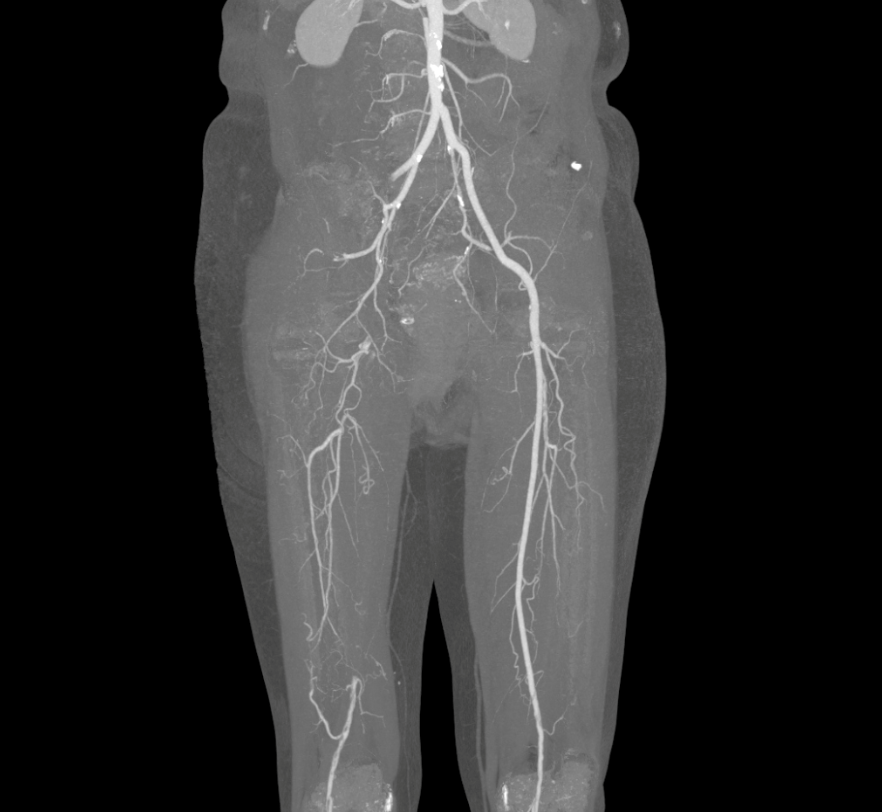Doctor Pham Ngoc Minh Thuy, a cardiovascular surgeon at Tam Anh General Clinic in District 7, diagnosed Kieu with acute thrombosis on a background of chronic vascular disease (narrowing due to atherosclerosis). The blood clot completely blocked the artery, extending from the right external iliac artery to the entire right femoral artery and the blood vessels below. This caused severe blood deficiency in the right leg, risking limb necrosis without treatment.
 |
MSCT scan shows atherosclerosis and scattered thrombi in the lower extremity arteries. Photo: *Tam Anh General Hospital* |
Due to the extensive thrombosis and complex calcification, the cardiovascular surgery team at Tam Anh General Hospital in Ho Chi Minh City decided to perform surgery to restore blood flow to the patient's right leg. After assessing cardiovascular risk factors and adjusting anticoagulant medication, the patient underwent surgery to remove the entire thrombus from the iliofemoral artery and the arteries in the lower leg, while also reconstructing and widening the severely narrowed section of the femoral and popliteal arteries.
According to Doctor Tran Thuc Khang, Deputy Head of the Cardiovascular Surgery Department at the Heart Center, to assess the success of the arterial revascularization (no residual stenosis, good blood flow below), the surgeon used an image intensifier for intraoperative examination.
Kieu's leg pain subsided, her leg became warm with restored sensation, and she was able to walk soon after the surgery. After five days of intensive treatment, the incision was dry and healing well, so she was discharged with scheduled follow-up appointments. The patient continues treatment with antithrombotic medication and management of accompanying cardiovascular risk factors.
 |
The surgical team operating on a patient. Illustrative photo: *Tam Anh General Hospital* |
Arterial thrombosis, where a blood clot forms within the artery itself, differs from an embolism, where a clot travels from elsewhere. Thrombosis can narrow or block blood flow, leading to insufficient blood supply to organs, including the lower limbs. The most common cause is underlying arterial disease (atherosclerosis); less common causes include hypercoagulability (a disorder that makes blood clot easily), excluding trauma.
The disease can occur suddenly, causing severe pain and risking limb loss, or it can develop silently with subtle symptoms that patients often overlook until the leg is severely damaged, according to Doctor Thuy. Depending on the extent and speed of thrombus formation, symptoms include calf pain when walking that lessens with rest (also known as intermittent claudication), cold feet, numbness, pale skin or slow-healing ulcers, hair loss, brittle or easily broken toenails, and calf muscle atrophy. In advanced stages, the patient experiences continuous pain even at rest, with ulcers or necrosis of the toes.
Doctors advise individuals with any unusual signs to seek medical attention for timely treatment. Treatment options for arterial thrombosis include medication, endovascular intervention, or surgery. For prevention, individuals should walk for 30 minutes daily, eat a healthy diet (rich in vegetables, fish, and whole grains, while limiting harmful fats), quit smoking, maintain a healthy weight, manage underlying diseases (if any), and have regular cardiovascular checkups.
Ngoc Chau
*The patient's name has been changed.
| Readers can submit questions about cardiovascular diseases here for doctors to answer. |












